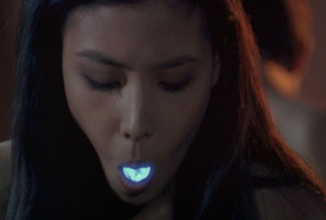"You can't fool me. People think you're human, but I can see your tails."
Synopsis:
Messenger No. 69 (Dokko Young-jae) is an office worker in Hell who is mistakenly chosen to go on a mission to earth to kill the last fox girl - a nine-tailed fox spirit called Harah (Ko So-young) who has taken human form temporarily to enable her to find a man whose energy she can steal and liver she can rip out and eat, in order to become human once and for all.
As Messenger No. 69 begins his pursuit of her, Harah saves a man, Hyuk (Jung Woo-sung), who has been badly injured by thugs, and after nursing him back to health they invariably begin a relationship.
However, though their love for each other outwardly appears to be growing, Hyuk is completely unaware that Harah has decided he is the human male she has been searching for, and is planning to make him her victim...
 |
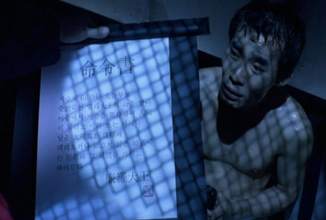 |
Review:
Take a look at mythology from almost any corner of the globe and you'll find legends and folklore of creatures with the outward appearance of beautiful women, ensnaring hapless males - using seduction, sex and feminine wiles to bring them to their demise and/or eternal damnation. From the Sirens of ancient Greece to the Succubi of Western medieval legends, stories of these 'femme fatales' primarily served as veiled cautionary tales to the dangers of succumbing to base instincts and/or sexual desires.
Varied though these legends were, and are, and while many involve the sexual act or the 'sucking' of energy from male victims, few are as deeply sensual or evocative as Korean folklore tales of the Gumiho - a nine-tailed fox-spirit masquerading (most often) as a sultry and stunningly beautiful woman, attempting to become permanently human in its 1000th year by draining the life force from a male (by use of an otherworldly 'marble' during sex) and ultimately eating their liver or, in some versions, the heart, freshly harvested from their lover/victim while still alive. Though at one time in Korea, as well as in other Asian cultures, many-tailed fox spirits were sometimes shown as benevolent creatures, as time passed Korean folk tales came to more regularly depict them as malevolent and fully prepared to sacrifice the life of any male they ensnare to enable them to finally become human, at any cost.
However, within The Fox with Nine Tails' story of Harah (the fox girl), both romance and sympathy for her plight are added to the mix, thereby allowing her depiction to be much more than simply good or evil, as well as ensuring that the film is ultimately a much more human tale (if you will) than would otherwise have been possible.
The addition of these elements was likely a result (certainly in part, at least) of the predominance of the genres of melodrama and/or romance in Korean cinema at the time (still hugely prevalent in Korean films, even now) and, to this day, their inclusion serves to strike a chord of both poignancy and familiarity with fans of classic, archetypal Korean love and melodrama storylines:
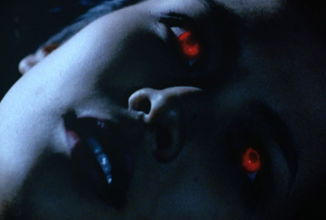 |
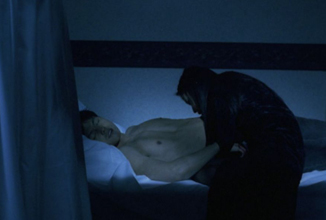 |
From the early stages of The Fox with Nine Tails, Harah's pain from having to do whatever is necessary to achieve her goal is clearly shown - she repeatedly cries in anguish after killing human and animal alike, mournfully howling at the moon with blood on her lips and hands - and while she knows she really has no option but to kill in order to ultimately become human; to feed; and to prevent individuals from destroying her chances, her violent fox-like actions sit squarely at odds, inside her, with the human she so desperately wants to be.
As Harah’s relationship with Hyuk becomes more intense and passionate, the question of whether she is truly falling in love or just using him for her own ends is indeed raised, but it also gradually shifts to asking (both Harah and viewers) if she really will be prepared to pay for her humanity with his life, and if he will ultimately let her do so even after learning that her success will only come with his death.
Ultimately, Harah becoming a human being will come at a huge cost not only to her victims and those who stand in her way, but also to herself - the nearer she gets to her goal, the more animalistic (and less humane) her actions need to be and, as such, she increasingly risks losing the very thing that truly makes us human - the humanity she so desperately seeks and is going to such great lengths to find.
The visuals in the final scene of The Fox with Nine Tails underline and reinforce this idea perfectly, and ensure that Harah's story holds a moral worthy of the folklore on which it's based.
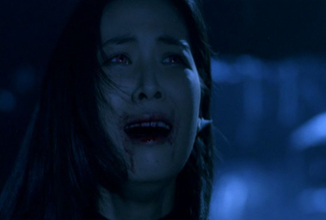 |
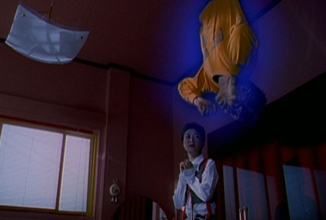 |
The side of The Fox with Nine Tail’s narrative dealing with Harah and Hyuk's relationship plays in classic romantic melodrama style and has a somewhat dream-like quality, further enhanced by sweeping (synthesiser) musical arrangements. Bright, warm and colourful indoor scenes of Harah living and working as a normal person (to outside eyes, at least) juxtaposed with sultry nighttime bedroom lighting during her liaisons with Hyuk serve to repeatedly give the feeling of showing what her life would be like if she finally managed to become permanently human - the latter being both sensual and also fitting perfectly with the subsequent darkening, and added poignancy, of the conclusion to both Harah and Hyuk’s character arcs.
As well as the romance and melodrama elements already mentioned, The Fox with Nine Tails largely introduced the genre of fantasy horror to Korean cinema audiences with its depiction of Messenger No. 69's mission to kill the elusive fox girl, and was, in fact, the first Korean film to use CGI effects. These are used fairly sparingly throughout the film (most likely because of cost) but are more effectively placed as a result, and though they are (obviously) nowhere near the quality of CGI today, they do have an almost quaint charm, and sometimes humour, to them that both brings a smile and fits well within the fantasy/comedy/horror aspects of the film.
 |
 |
The narrative elements centering around Messenger No. 69 and his efforts to find and kill Harah run parallel to her storyline for the majority of the plot, gradually converging with it as the film approaches its culmination, and these scenes are fairly frenetic - especially by comparison – but still deftly merge fantasy and horror with copious amounts of tongue-in-cheek humour. However, while they do allow a temporary lightening of proceedings and a quickening of pace, they are so utterly different in feel to the more sensual sections that they rather seem like a different film entirely.
That said, the horror/comedy and love story narrative threads do each work in their own right and once viewers have become familiar with the regular altering of style and speed (as the plot moves between love, horror, laughter and tears), they can largely be appreciated together, in spite of their differences.
Cast:
The entire cast give accomplished performances throughout The Fox with Nine Tails. Of the two main characters, Harah is, unsurprisingly, given far greater depth than Hyuk, and, as such Ko So-young portrayal of the fox girl has much more for her to get her teeth into, as it were.
Jung Woo-sung, as Hyuk, certainly does his best but his character is really little more than a supporting role to that of Harah.
However, with the humour and faster pacing of Messenger 69’s individual narrative, Dokko Young-jae’s performance as the somewhat bumbling office worker from Hell easily equals that of either of the two leads, and note should also be made of Bang Eun-hee’s portrayal of Messenger 69’s only disciple, Min-hee, who, though she has much less on-screen time, still manages to produce a performance both memorable and repeatedly funny.
Cast: Ko So-young, Jung Woo-sung, Dokko Young-jae, Bang Eun-hee
Directed by: Park Heon-su
Summary:
With the age-old Korean folklore of a fox spirit attempting to become human at its core, The Fox with Nine Tails merges fantasy, horror, romance and melodrama to create a tale with a moral worthy of the legend on which it’s based.
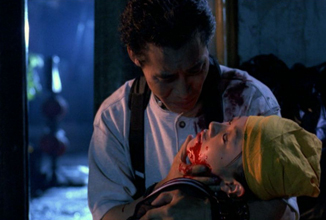 |
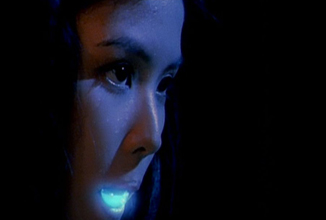 |
DVD
The DVD
edition reviewed here is the Korean (Region ALL) Bitwin Single Disc Edition release. The film itself is
provided as an anamorphic transfer with an aspect ratio of 1.85:1 and there are no image artifacts (and no ghosting) present. However, the image quality is somewhat grainy in several sections of the film, especially scenes taking place at night, and though this doesn't actually spoil enjoyment of the film, it is noticeable, nonetheless.
The original Korean
language soundtrack is provided as Dolby Digital 2.0 and here too the quality is rather less than it should be - regularly in quieter sections of the film, a crackling akin to the sound of a vinyl record being played is audible.
Both this and the aforementioned image graininess may well simply be due to the age of the film, but I really wouldn't be doing my duty if I didn't point these issues out anyway.
Excellent subtitles are provided
throughout the main feature but English-speaking viewers should note that, as with many Korean DVD releases, there are no subtitles available on any of the extras.
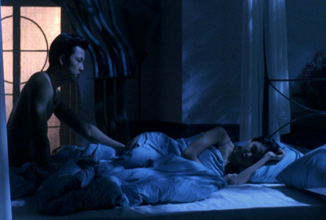 |
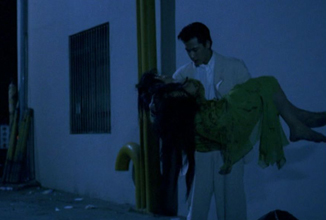 |
DVD
Details:
• Director: Park Heon-su
• Format: NTSC,
Anamorphic, Widescreen, Subtitled
• Language: Korean
•
Subtitles: English/Korean
•
Sound: Dolby Digital 2.0
• Region: Region ALL
• Aspect Ratio:
1.85:1
• Number of discs: 1
• Classification: 15 (Korean Film Classification)
• Studio:
Bitwin
• Run Time: 107 minutes (approx.)
DVD Extras:
- Interactive Menus
- Scene Selections
- Cast/Director Profiles
- Trailer
|










